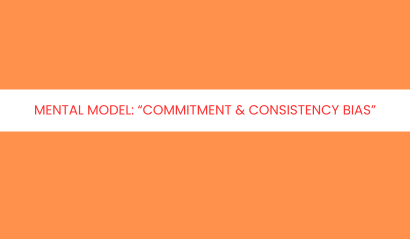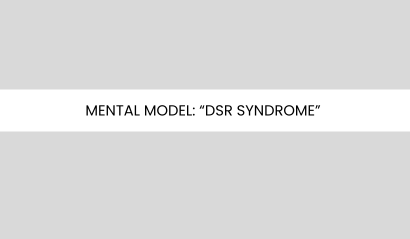Mental Model: Commitment & Consistency Bias
Humans like to see themselves as rational beings who make logical decisions based on facts and reasoning. However, psychology tells us otherwise. Our decisions are often influenced by cognitive biases—mental shortcuts that can sometimes lead us astray. One of the most powerful biases affecting human behavior is the Commitment & Consistency Bias. This bias explains why people tend to stick to their past decisions and behaviors, even when presented with evidence that contradicts their choices. This blog post explores the origins of this bias, how it manifests in daily life, its implications, and ways to avoid falling into its trap.
The Origins of Commitment & Consistency Bias
Commitment & Consistency Bias is rooted in the principles of cognitive dissonance and social influence. It was extensively studied by social psychologist Robert Cialdini, who introduced it in his book Influence: The Psychology of Persuasion (1984). According to Cialdini, once we make a choice or take a stand, we face psychological pressure to behave consistently with that commitment.
This tendency to remain consistent is linked to two major psychological factors:
- Cognitive Dissonance – Coined by psychologist Leon Festinger in 1957, this concept suggests that people experience discomfort when their actions contradict their beliefs. To reduce this discomfort, they justify their choices—even when they are irrational.
- Social Proof and Reputation – In social settings, consistency is valued. People who frequently change their minds are seen as unreliable or untrustworthy. Therefore, once we commit to something publicly, we feel compelled to follow through to maintain our reputation.
How Commitment & Consistency Bias Works
At its core, Commitment & Consistency Bias is a mental shortcut. When we commit to something, our brain reduces the need for constant decision-making by relying on past commitments as a guide for future actions. Here’s how it typically unfolds:
- A small initial commitment is made – This could be signing a petition, making a small purchase, or agreeing to a minor request.
- Psychological ownership develops – Once we commit, we start identifying with that decision, making it harder to back out.
- We seek consistency with past behavior – Future choices align with that commitment, even if the circumstances change or new information arises.
This mechanism allows us to navigate life efficiently but can also lead to poor decision-making when it prevents us from reevaluating past choices.
Real-World Examples of Commitment & Consistency Bias
Commitment & Consistency Bias is evident in various aspects of life, from marketing and business to relationships and everyday decisions.
1. Marketing & Sales Strategies
Companies leverage this bias to increase customer engagement and loyalty. Consider these strategies:
- Foot-in-the-door technique: Marketers first ask for a small commitment before escalating the request. For example, a company might offer a free trial, knowing that once customers commit, they are more likely to subscribe.
- Loyalty programs: Once consumers start collecting reward points, they feel compelled to continue shopping at the same store to maintain consistency.
- Public commitments: Many fitness programs encourage participants to share their goals online. Once people commit publicly, they feel pressure to follow through.
2. Politics & Public Opinion
People often remain loyal to political parties, even when new evidence suggests that their chosen party no longer aligns with their best interests. This bias explains why voters may continue supporting policies or leaders despite scandals or policy failures—once committed, changing opinions feels psychologically uncomfortable.
3. Investments & Financial Decisions
Investors often fall victim to the sunk cost fallacy, a close cousin of Commitment & Consistency Bias. When people invest money in stocks, businesses, or projects, they tend to stick with them—even when it’s clear that cutting losses would be the wiser decision.
4. Relationships & Social Commitments
Many people remain in unhealthy relationships because they’ve invested time and emotions into them. The desire to stay consistent with their past decision (“I chose this person, so I must make it work”) keeps them from making rational choices about their well-being.
5. Workplace & Leadership
Employees who publicly commit to a company initiative may find it difficult to admit later that the idea was flawed. Similarly, leaders may continue to push unsuccessful strategies because reversing course would mean acknowledging past mistakes.
The Dangers of Commitment & Consistency Bias
While commitment and consistency can be positive traits—helping us build habits, maintain relationships, and stay goal-oriented—they can also lead to significant drawbacks:
- Poor Decision-Making – When people refuse to change course despite new evidence, they may persist in ineffective or harmful behaviors.
- Exploitation – Marketers, politicians, and even con artists exploit this bias to manipulate people into making irrational commitments.
- Resistance to Change – Businesses and individuals may struggle with innovation because they are too attached to past commitments.
- Emotional Distress – Staying in an unhealthy relationship or toxic work environment due to consistency pressure can lead to prolonged stress and dissatisfaction.
How to Avoid Commitment & Consistency Bias
Recognizing this bias is the first step to overcoming it. Here are practical strategies to mitigate its effects:
1. Be Willing to Reevaluate Your Decisions
Regularly reassess your commitments. Ask yourself:
- “Would I make the same decision today knowing what I know now?”
- “Am I sticking to this choice because it’s the best one or just because I don’t want to change my mind?”
2. Beware of Small Initial Commitments
Since minor commitments can lead to larger obligations, be mindful before saying “yes.” If someone asks you for a small favor or participation, consider whether this could lead to greater pressure later.
3. Separate Identity from Decisions
Avoid tying your self-worth to past choices. Being wrong doesn’t mean you are incompetent; it means you are learning. Successful people adapt when they gain new insights.
4. Watch for Manipulation
Be cautious when businesses, marketers, or politicians use commitment-based strategies. If someone asks you to make a seemingly harmless pledge, think about how it might influence future behavior.
5. Embrace Flexibility
Train yourself to be open-minded. Read different viewpoints, consider alternative perspectives, and remind yourself that changing your mind is a sign of growth, not weakness.
6. Use Decision-Making Frameworks
Apply structured approaches to decision-making, such as cost-benefit analysis, to ensure rationality over emotional bias.
Conclusion
Commitment & Consistency Bias is a powerful psychological force that shapes our decisions, often without us realizing it. While consistency can be a valuable trait, blindly sticking to past commitments can lead to irrational and harmful choices. By being aware of this bias, questioning our commitments, and embracing flexibility, we can make better, more informed decisions in both our personal and professional lives. Next time you find yourself holding onto a choice just because it’s what you’ve always done—pause, reflect, and ask yourself whether it’s truly the best path forward.







